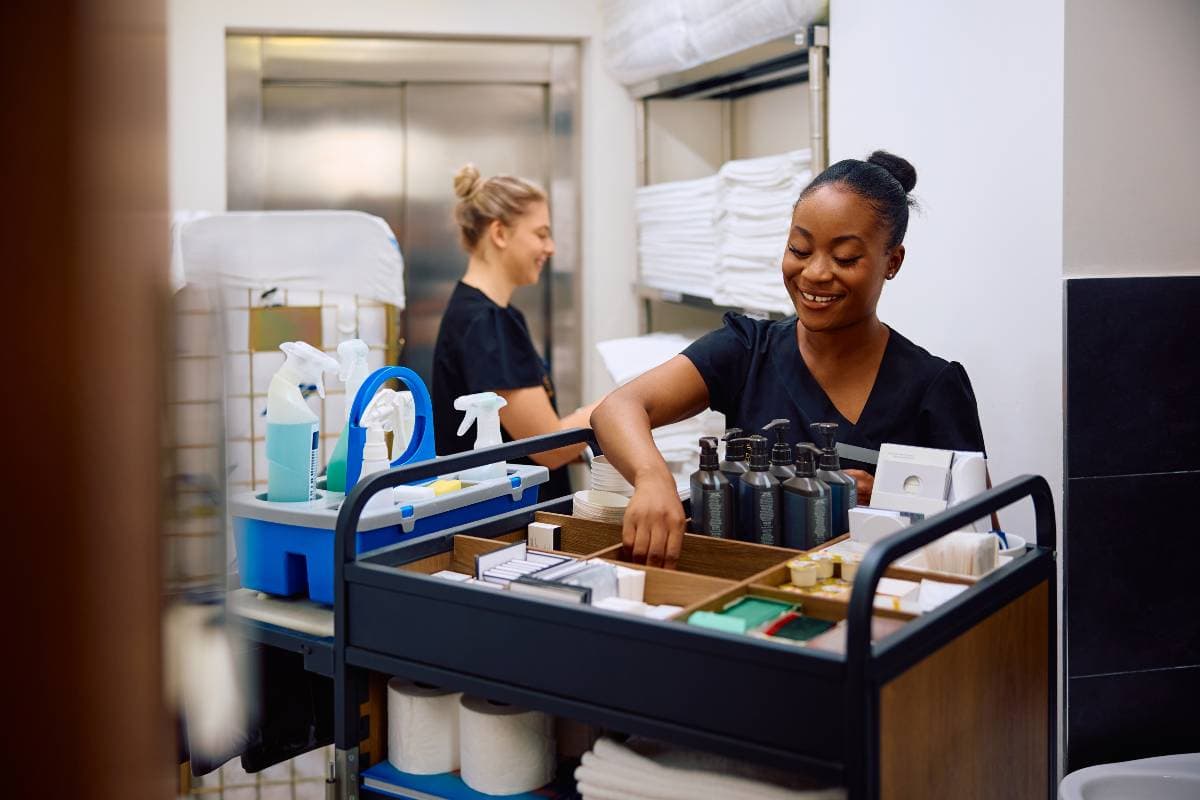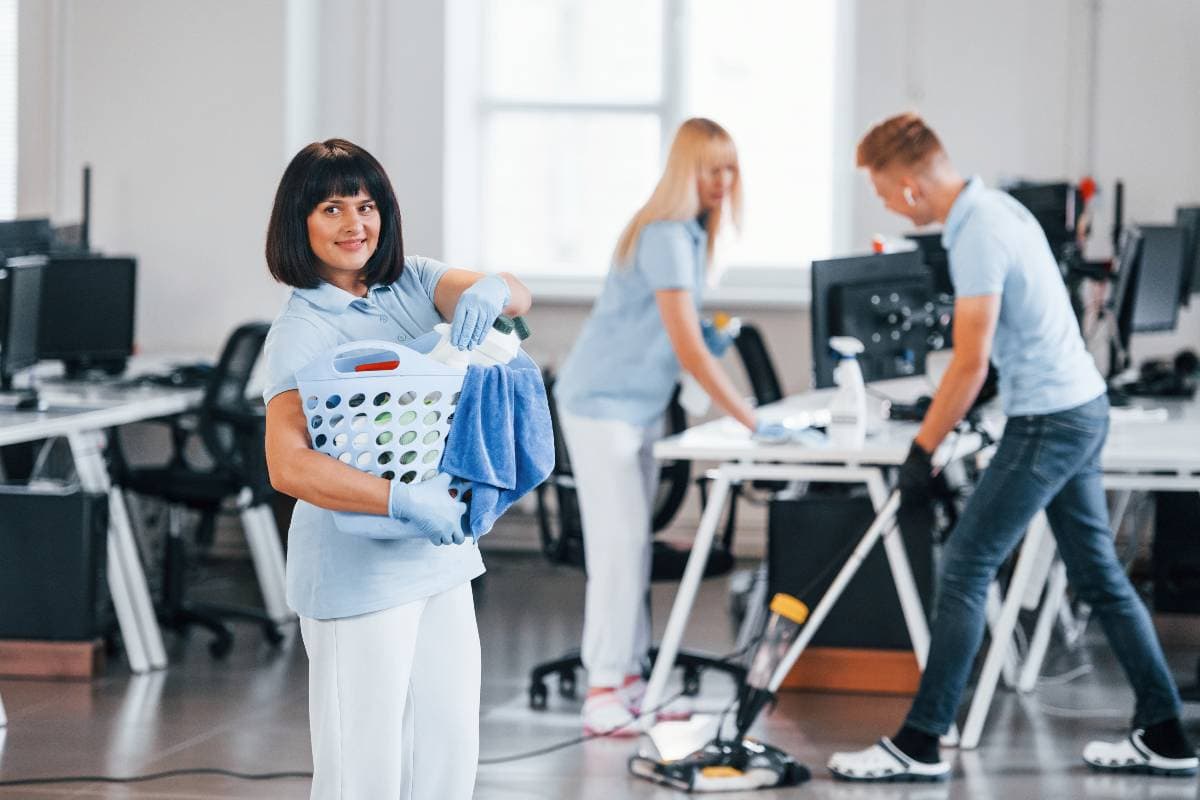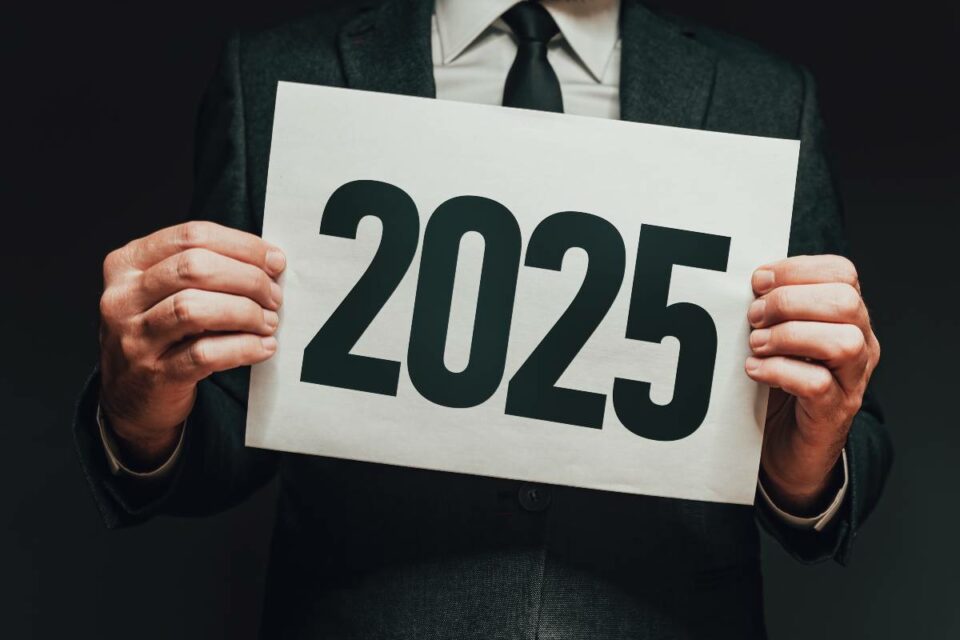Let’s face it – keeping your commercial space clean can feel like a never-ending battle, especially when you’re trying to keep costs down. As someone who’s spent nearly two decades in the commercial real estate trenches, I’ve seen firsthand how a grimy office can turn off potential clients faster than you can say “dust bunny.” But here’s the good news: achieving a spotless space doesn’t have to mean emptying your wallet.
Key Takeaways
- Learn how to assess and optimize your cleaning needs for maximum cost-efficiency
- Discover innovative technologies and green practices that can reduce cleaning costs
- Understand how to balance cost-cutting measures with maintaining high cleanliness standards
Assessing Your Cleaning Needs
Before we roll up our sleeves and start scrubbing, let’s take a step back and assess the situation. Think of it as a cleaning audit – we need to know what we’re dealing with before we can tackle it effectively.
First things first, let’s talk money. Evaluating current cleaning costs is crucial. Pull out those invoices and receipts – we’re going to do some number crunching. Are you spending a fortune on daily deep cleans when a weekly once-over might suffice? It’s time to separate the essential from the nice-to-have.
Next, we need to set some goals. How much do you want to trim from your cleaning budget? 10%? 20%? Whatever your target, make it clear and measurable. We’re aiming for cost-effective janitorial solutions, not cheap and nasty.
Lastly, let’s roll up our sleeves and conduct a thorough cleaning audit. This isn’t just about counting mop buckets – we’re looking at the big picture. Here’s what to consider:
- Traffic patterns: Which areas see the most foot traffic?
- Surface types: Do you have mostly carpet, hardwood, or a mix?
- Special requirements: Any areas that need extra attention, like kitchens or restrooms?
By the end of this assessment, you should have a clear picture of your cleaning needs and where your money is going. Trust me, this groundwork will pay off in spades later.
Optimizing Cleaning Processes
Now that we’ve got a handle on our needs, it’s time to get efficient. Optimizing cleaning processes is where the rubber meets the road in cost-effective cleaning.
First up, let’s talk about streamlining cleaning routes. I once had a client who was paying for cleaners to zigzag across their office like a game of Pac-Man. We reorganized their cleaning route, and boom – instant time (and money) savings. The key is to create a logical flow that minimizes backtracking.
Next, let’s dive into efficient cleaning techniques. This isn’t about working harder; it’s about working smarter. For instance, did you know that starting from the top and working your way down can save time and prevent re-cleaning? It’s these little tricks that add up to big savings.
Now, let’s talk tech. Leveraging technology in cleaning isn’t just about fancy gadgets (although those can be pretty cool). It’s about using tools that boost productivity. For example, microfiber mops can clean more efficiently and require less water and cleaning solution. That’s a win-win in my book.
But all the fancy equipment in the world won’t help if your team doesn’t know how to use it properly. That’s why training staff is crucial. Invest in regular training sessions to keep your cleaning crew up-to-date on the latest techniques and technologies.
Lastly, let’s get data-driven. Implementing data-driven cleaning schedules can revolutionize your approach. By analyzing foot traffic patterns and usage data, you can create a cleaning schedule that tackles areas when they need it most, not just on a fixed rotation.
Success Stories
Data-driven cleaning strategies have proven effective for many facilities certified by the GBAC STAR program, which provides comprehensive training in cleaning, disinfection, and infectious disease prevention.
One success story involves a large New York City office complex housing 470 toilets. By implementing sensor technology to monitor restroom usage and cleanliness, the facility uncovered patterns in high and low-traffic periods. This insight allowed the cleaning team to optimize their schedules, focusing more attention on busier times. The result was a marked improvement in restroom cleanliness and increased tenant satisfaction.
Another example comes from a major global hotel chain operating 1,350 properties. They developed a data-centric quality assurance system using portable devices to track various cleaning metrics, including time spent per room, adherence to protocols, and guest feedback.
Analysis of this data highlighted specific areas where cleaning standards weren’t being met. The chain then implemented targeted training programs to address these issues, leading to enhanced cleaning quality and improved guest satisfaction scores.
A third case involves a bustling international airport serving 62 million annual passengers across five terminals and 130 boarding gates. The airport employed data analytics to refine its cleaning approach. By examining data on passenger flow and space utilization, the cleaning team could prioritize high-traffic areas in their cleaning routines. This data-driven strategy not only boosted overall cleanliness but also had positive impacts on passenger satisfaction and safety.
These examples demonstrate how data-collecting technology and analytics can significantly improve cleaning operations and outcomes in various large-scale facilities.
Smart Product and Equipment Choices
Alright, let’s talk shop – cleaning shop, that is, focusing on janitorial services and their impact. Making smart choices when it comes to cleaning supplies and equipment can make a world of difference to your bottom line.
First up, let’s consider cost-effective cleaning supplies. Now, I’m not saying you should buy the cheapest products on the shelf. In fact, that can often backfire, leading to more frequent replacements or ineffective cleaning. Instead, look for office cleaning products that offer the best value for money. Sometimes, spending a bit more upfront on specialized cleaning can save you in the long run.
Next, let’s chat about energy-efficient equipment. These babies aren’t just good for the planet; they’re great for your wallet too. For example, a high-efficiency vacuum cleaner might cost more initially, but it’ll use less energy and clean more effectively, saving you money over time.
Here’s a pro tip: embrace multi-purpose cleaning products. Why buy five different cleaners when one can do the job? Not only does this save money, but it also simplifies your cleaning process and reduces storage needs.
Now, let’s get green. Exploring green cleaning solutions isn’t just a trendy move – it can lead to significant cost savings. Many eco-friendly products are concentrated, meaning they last longer and require less packaging. Plus, they’re often safer for your surfaces and your cleaning staff.
Lastly, don’t forget to consider the total cost of ownership for your cleaning equipment. This includes not just the purchase price, but also maintenance costs, energy usage, and expected lifespan. Sometimes, a more expensive machine can be cheaper in the long run if it’s built to last and operates efficiently.
Customizing Cleaning Services
One size definitely doesn’t fit all when it comes to commercial cleaning services. Customization is key to ensuring you’re getting exactly what you need – no more, no less.
Let’s start with tailoring cleaning schedules. Maybe your office doesn’t need a full cleaning every single day. Perhaps certain areas need more frequent attention while others can go longer between cleanings. By adjusting your cleaning frequency to match your actual needs, you can significantly cut costs without sacrificing cleanliness.
Next, let’s focus on those high-traffic areas. These hotspots – like entryways, break rooms, and bathrooms – often need more frequent cleaning. By concentrating your efforts here, you can maintain a clean appearance where it matters most while potentially reducing cleaning in less-used areas.
Now, here’s a strategy that can really make a difference: zone-based cleaning. This approach involves dividing your space into different zones based on cleaning needs. For example:
- Zone 1: High-traffic areas (daily cleaning)
- Zone 2: General office space (2-3 times per week)
- Zone 3: Low-use areas (weekly or bi-weekly)
This targeted approach ensures you’re not over-cleaning some areas while neglecting others.
The goal is to strike a balance between cost-effectiveness and quality. You want to trim the fat from your cleaning budget, not cut into the muscle of your cleaning program.

Cost-saving Strategies in Cleaning Contracts
Now, let’s talk turkey – or in this case, cleaning contracts. Negotiating favorable terms with your cleaning provider can lead to significant savings, but it requires a bit of savvy.
First off, don’t be afraid to shop around. Get quotes from multiple providers and use this information to negotiate better rates. But remember, the lowest price isn’t always the best deal. You want a provider who offers quality service at a fair price.
Consider exploring flexible contract options. For example, you might negotiate a contract that allows you to adjust service levels based on your needs. This can be particularly useful if your business has seasonal fluctuations.
Here’s a pro tip: look into performance-based agreements. These contracts tie payment to the quality of service provided, incentivizing your cleaning company to maintain high standards. It’s a great way to ensure you’re getting what you pay for.
Lastly, think long-term. Considering long-term partnerships with cleaning providers can often lead to better rates. Providers are often willing to offer discounts for longer contracts or for clients who use multiple services.
A good cleaning contract should be a win-win. You get the service you need at a price you can afford, and your provider gets a stable, satisfied client. Don’t be afraid to negotiate – you might be surprised at what you can achieve!
Embracing Green Cleaning Practices
Let’s go green! And no, I’m not talking about painting your office (although a fresh coat never hurts). I’m talking about embracing green cleaning practices. Not only is this good for the planet, but it can also be great for your wallet.
First off, let’s talk about the average cost of various types of cleaning. benefits of eco-friendly cleaning methods. These practices often use fewer harsh chemicals, which means less risk to your employees’ health and your building’s surfaces. Plus, many green cleaning products are concentrated, meaning they last longer and require less packaging.
Now, here’s where it gets really interesting – the cost advantages of sustainable cleaning practices. Many businesses find that going green actually saves them money in the long run. How? Well, green cleaning products often require less water and energy to use effectively. Plus, they can help extend the life of your surfaces and equipment.
Let’s not forget about implementing recycling programs. This isn’t just about separating paper and plastic (although that’s important too). It’s about looking at your entire cleaning process and finding ways to reduce waste. For example, using refillable cleaning bottles instead of disposable ones can lead to significant savings over time.
Water and energy conservation are also key components of green cleaning. Adopting water and energy conservation techniques not only reduces your environmental footprint but can also lead to lower utility bills. Win-win!
Lastly, don’t underestimate the power of green certifications. These can be a great marketing tool, helping you attract environmentally conscious tenants or clients. Plus, many certified green cleaning products and methods are designed to be more efficient, leading to cost savings.
Going green isn’t just about being eco-friendly – it’s about being smart with your resources. And in business, that’s always a good thing!
Leveraging In-house Resources
Now, let’s talk about tapping into a resource you already have – your people. Leveraging in-house resources Supplementing your professional cleaning services with specialized cleaning options can be a great way to keep costs down.
First up, consider encouraging employee participation in basic cleaning tasks. I’m not suggesting your CEO should be scrubbing toilets, but simple actions like wiping down their own desk or cleaning up after themselves in the break room can make a big difference.
Implementing a clean desk policy is another smart move. Not only does this create a more organized work environment, but it also makes it easier and quicker for cleaners to do their job effectively.
Promoting workplace cleanliness awareness is key. This could involve putting up friendly reminders about keeping common areas tidy or organizing occasional ‘clean-up days’ where everyone pitches in. It’s amazing how a little team spirit can translate into a cleaner office and lower cleaning costs.
But here’s the important part – balancing in-house efforts with professional services. While employee participation is great, it shouldn’t replace professional cleaning. The goal is to complement your professional services, not substitute them entirely, especially in areas like carpet cleaning and window cleaning.
Monitoring and Measuring Cleaning Performance
Alright, let’s get down to brass tacks. How do you know if your cleaning efforts are actually paying off? That’s where monitoring and measuring cleaning performance comes in.
You need to establish some key performance indicators (KPIs). These could include things like cleanliness scores, customer satisfaction ratings, or even the number of complaints received. The key is to choose metrics that are relevant to your specific needs and goals.
Next up, regular cleaning audits are crucial. These shouldn’t be a gotcha moment for your cleaning staff, but rather an opportunity to identify areas for improvement. Consider using a standardized checklist to ensure consistency in your evaluations.
Don’t forget about the power of feedback. Utilizing customer feedback can provide valuable insights into the effectiveness of your cleaning program. Consider setting up a simple system for tenants or employees to report cleaning issues or offer suggestions.
Remember that this isn’t a set-it-and-forget-it situation. Adjusting strategies based on performance data is key to continual improvement. If certain areas consistently score low on cleanliness audits, it might be time to increase cleaning frequency or change up your approach.
Innovative Technologies in Commercial Cleaning
Hold onto your mop buckets, folks, because we’re about to dive into the future of cleaning! Innovative technologies are revolutionizing the commercial cleaning industry, and trust me, it’s exciting stuff.
First up, let’s talk about IoT-enabled cleaning equipment. Imagine a world where your vacuum cleaner tells you when it needs maintenance, or your soap dispensers alert you when they’re running low. Well, that world is here! These smart devices can help optimize your cleaning schedule and prevent costly breakdowns.
Next, consider implementing automated scheduling and task management systems. These nifty tools can help streamline your cleaning operations, ensuring tasks are completed efficiently and nothing falls through the cracks.
Now, here’s where it gets really sci-fi: utilizing data analytics for predictive cleaning. By analyzing patterns in foot traffic, weather, and other factors, these systems can predict when and where cleaning will be needed most. It’s like having a crystal ball for your cleaning needs!
Let’s talk about our new robot overlords – or at least, our new robot cleaners. Adopting robotics and AI in cleaning processes can lead to more consistent, round-the-clock cleaning with less human intervention. From robotic vacuum cleaners to AI-powered scrubbers, these technologies are changing the game.
Health and Safety Considerations in Cost-effective Cleaning
Now, let’s talk about a topic that’s more important than ever – health and safety. When we’re looking at cost-effective cleaning, it’s crucial that we don’t cut corners when it comes to hygiene and safety standards.
First off, let’s address the elephant in the room – or should I say, the virus in the air. The COVID-19 pandemic has changed the game when it comes to cleaning protocols. Balancing cost-cutting with hygiene standards is more important than ever. This might mean investing in more frequent cleaning of high-touch surfaces or using hospital-grade disinfectants.
One way to maintain high standards while keeping costs in check is by implementing touchless cleaning solutions. These can include things like sensor-operated soap dispensers or foot-operated door openers. Not only do these reduce the spread of germs, but they can also lead to less product waste.
When it comes to addressing pandemic-related cleaning requirements, it’s important to stay up-to-date with the latest guidelines from health authorities. This might mean additional training for your cleaning staff or investing in new cleaning technologies.
Don’t forget about ensuring compliance with health and safety regulations. This isn’t just about avoiding fines (although that’s important too). It’s about creating a safe environment for everyone who uses your space.

Future Trends in Cost-effective Commercial Cleaning
First up, let’s talk about emerging technologies and their potential impact. We’re seeing some really exciting developments in the world of cleaning tech. For instance, UV-C light disinfection is becoming more mainstream, offering a chemical-free way to sanitize spaces. We’re also seeing advancements in nanotechnology, which could lead to surfaces that actually repel dirt and bacteria. Imagine how that could change the cleaning game!
Now, let’s consider evolving customer expectations and demands. In the wake of the pandemic, we’re seeing a heightened focus on health and hygiene. Clients aren’t just looking for clean anymore – they want demonstrably sanitized spaces. This might mean investing in more sophisticated cleaning technologies or increasing the frequency of deep cleaning.
As for predictions for the commercial cleaning industry, I see a few key trends emerging:
- Increased adoption of automation and AI in cleaning processes
- A greater emphasis on sustainability and eco-friendly cleaning practices
- More demand for transparent cleaning protocols and results
One thing’s for sure – the cleaning industry isn’t going to stand still. By staying ahead of these trends, you can ensure your cleaning strategy remains both cost-effective and cutting-edge.
FAQs
What factors influence the commercial cleaning cost?
How much does commercial cleaning typically cost per square foot?
What are the average commercial cleaning rates for office cleaning?
How can I save on cleaning expenses for my commercial building?
What types of commercial cleaning services are available?
Conclusion
Implementing cost-effective cleaning strategies is not a one-time thing. It’s an ongoing process of evaluation, adjustment, and improvement. But trust me, the payoff is worth it. Not only will you see savings in your cleaning budget, but you’ll also create a healthier, more pleasant environment for everyone who uses your space.
So, are you ready to revolutionize your approach to commercial cleaning? Great! But you don’t have to go alone to it. As a seasoned professional in the commercial real estate industry, I’ve helped countless businesses optimize their cleaning strategies. Why not leverage that expertise for your benefit?
Ready to take the next step towards cost-effective, high-quality commercial cleaning? Let’s chat! Schedule a consultation with me, and we’ll dive deep into your specific cleaning needs and challenges. Together, we can craft a cleaning strategy that keeps your space spotless and your budget intact. Don’t wait – a cleaner, more cost-effective future is just a conversation away!




